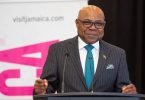Over the past few days, Melbourne has been hosting the Australia Tourism Exchange, one of Australia’s largest travel industry trade expos. As a result of concern about swine flu, a large number of would-be delegates from Asian countries canceled. Over 30 percent of registrants from Singapore canceled due to concerns raised by the Singapore government’s travel advice on Australia, which featured the threat of swine flu.
Of the 25,000 recorded global cases of the swine flu virus some 1,500 cases have been recorded in Australia, which is well into its traditional winter flu season. Of those, the majority (over 1,000) of H1N1 cases are in the state of Victorian, a state which is jokingly referred to by many Australians as “Mexico” due to its location south of the country’s largest river, the Murray river (not because of the prevalence of swine flu). On a per capita basis Melbourne is the current swine flu (H1N1) capital of the world.
However Australians are taking a phlegmatic approach to swine flu. When swine flu initially surfaced in Mexico, the Australian media suffered an attack of apocalyptic apoplexy but as Australia has now experienced a significant outbreak the media has reported the situation with commendable sobriety. Australians are not walking the streets of the nation’s cities wearing surgical masks or indeed showing any outward signs of panic.
When the Japanese national soccer team arrived in Melbourne a few days ago to prepare for a World Cup qualifying match against the Australian Socceroos they were the only people in Melbourne (apart from doctors performing surgery) wearing surgical masks.
The greatest concern aroused in Australia was the near cancellation of a major club rugby league football match between the Bulldogs and the Broncos because a couple of the players had swine flu forcing one team (the Brisbane Broncos) to be in quarantine and miss a couple of training sessions. However, it takes a far more dire threat to national health than swine flu to cancel a footy match in Australia.
The Federal government has amassed vast supplies of flue vaccine. The government has exercised an active containment policy since the initial outbreaks in Mexico. All international gateway airports are equipped with heat sensors. Schools are closed for a week if any pupil is found to have the disease, individuals and families have been quarantined if there is a suspected or actual case.
To date, there have been no fatalities in Australia due to swine flu, although health authorities nationally and in all states are monitoring the situation carefully. The relatively benign nature of the virus has tempered concerns about swine flu as a mortal threat to national health.
However, as Australian Health Minister Nicola Roxon has pointed out frequently, the health authorities are aware that flu viruses have the potential to mutate from a benign form to a life threatening form and that Australian health authorities are prepared to alter and activate heightened alert conditions if necessary.
The biggest concern aroused by the prevalence of swine flu in Australia is its actual and potential impact on inbound tourism to Australia. Swine flu has clearly aroused a fear factor among many of Australia’s traditional Asian source markets, some of whom incorrectly compare swine flu with SARS.
The World Health Organization’s (WHO) declaration of swine flu as a level 6 pandemic has contributed to creating a perception of the disease as being a far more serious public health threat than it actually is. It clearly obliges the WHO to re-think its definitions of a pandemic, which are not in synch with standard medical definitions. As the term pandemic implies to most people a mortal threat, it may be worth revising the WHO definition to account for mortality levels in disease.
Australian Tourism Minister Martin Ferguson attempted to allay concerns in a speech he gave at the Australian Tourism Exchange by saying that tourists were safe and welcome. One would suspect it would take a more convincing PR campaign than the minister’s soothing rhetoric to convince some people from Asian countries that a visit to Australia and to Melbourne in particular will not result in them having a life threatening brush with swine flu.
In 2009, Australia has had to cope with far greater existential threats than swine flu including the Victorian bushfire in February and extensive flooding in Northern New South Wales and Southern Queensland in May, which affected and indeed inundated many popular tourism resorts.
As one wag has put it, Australia has increased its national threat assessment level from “no worries, mate” to “she’ll be right, mate.” There is no thought of incurring the most extreme threat level of “sorry, mate, we’re canceling the barbie.”
As Australia Prnime Minister Kevin Rudd was recently quoted in response to claims that swine flu was a national threat, “fair shake of the sauce bottle.”
(eTN): Swine flu central but no worries, mate | re-post license | post content






















